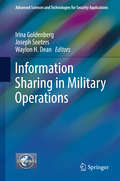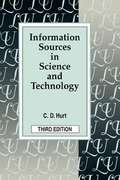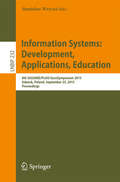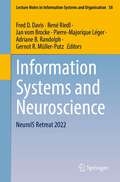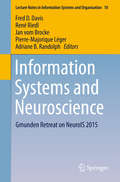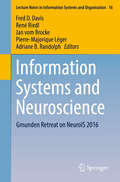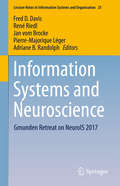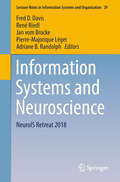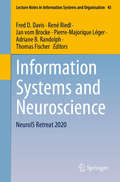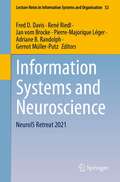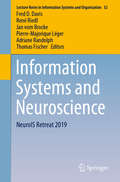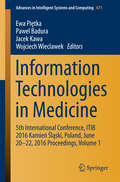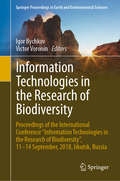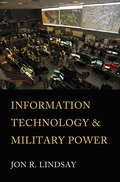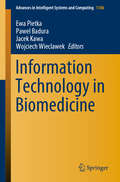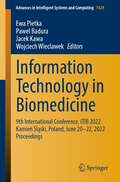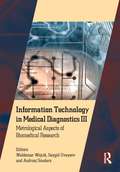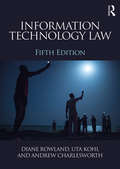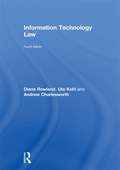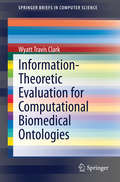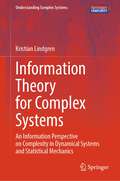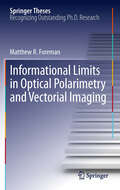- Table View
- List View
Information Sharing in Military Operations
by Irina Goldenberg Joseph Soeters Waylon H. DeanThis volume explores the interpersonal, organizational, and technological enablers and barriers to information and intelligence sharing in multinational and multiagency military, humanitarian, and counterterrorism operations. To this end the contributions present case studies and other empirical research. UN and special operations headquarters are studied, along with multinational operations in Mali, Iraq, and Afghanistan by the UN and by U. S. Central Command. Perennial themes are the need for a holistic approach to information sharing--one that incorporates all the above enablers--and the importance of learning from experience, which should be the basis for operational planning. There is still considerable ground to be gained in enhancing the efficacy of information sharing in the context of defense and security, and the present book contributes to this goal.
Information Sources in Science and Technology
by C. D. HurtA revised and updated text for library science students or as a library selection tool, serving as a critical guide to the secondary literature and an introduction to the pattern of primary literature published in the field of science and technology. It covers all types of reference material, with descriptive and evaluative annotations that define the scope of each work, its intended audience, and special features. Critical comments allow users to compare sources and make choices between similar titles. Paper edition (unseen), $32. Annotation c. by Book News, Inc., Portland, Or.
Information Systems: 8th SIGSAND/PLAIS EuroSymposium 2015, Gdansk, Poland, September 25, 2015, Proceedings
by Stanislaw WryczaThis book constitutes the refereed proceedings of the SIGSAND/PLAIS EuroSymposium 2015 titled Information Systems: Development, Applications, Education, held in Gdansk, Poland, in September 25. The objective of this symposium is to promote and develop high-quality research on all issues related to systems analysis and design (SAND). It provides a forum for SAND researchers and practitioners in Europe and beyond to interact, collaborate, and develop their field. The 11 papers presented in this volume were carefully reviewed and selected from 28 submissions. They are organized in topical sections on information systems development; business process modeling; and information systems education.
Information Systems and Neuroscience: NeuroIS Retreat 2022 (Lecture Notes in Information Systems and Organisation #58)
by Jan Vom Brocke René Riedl Pierre-Majorique Léger Fred D. Davis Adriane B. Randolph Gernot R. Müller-PutzThis book presents the proceedings of the NeuroIS Retreat 2022, June 14-16, Vienna, Austria, reporting on topics at the intersection of information systems (IS) research, neurophysiology and the brain sciences. Readers will discover the latest findings from top scholars in the field of NeuroIS, which offer detailed insights on the neurobiology underlying IS behavior, essential methods and tools and their applications for IS, as well as the application of neuroscience and neurophysiological theories to advance IS theory.
Information Systems and Neuroscience
by Fred D. Davis René Riedl Jan Vom Brocke Pierre-Majorique Léger Adriane B. RandolphThis book presents the proceedings of the Gmunden Retreat on NeuroIS 2015, reporting on topics at the intersection of Information Systems (IS) research, neurophysiology and the brain sciences. Readers will discover the latest findings from top scholars in the field of NeuroIS, which offer detailed insights on the neurobiology underlying IS behavior, essential methods and tools and their applications for IS, as well as the application of neuroscience and neurophysiological theories to advance IS theory.
Information Systems and Neuroscience
by Fred D. Davis René Riedl Jan Vom Brocke Pierre-Majorique Léger Adriane B. RandolphThis book presents the proceedings of the Gmunden Retreat on NeuroIS 2016, reporting on topics at the intersection of Information Systems (IS) research, neurophysiology and the brain sciences. Readers will discover the latest findings from top scholars in the field of NeuroIS, which offer detailed insights on the neurobiology underlying IS behavior, essential methods and tools and their applications for IS, as well as the application of neuroscience and neurophysiological theories to advance IS theory.
Information Systems and Neuroscience
by Fred D. Davis René Riedl Jan Vom Brocke Pierre-Majorique Léger Adriane B. RandolphThis book presents the proceedings of the Gmunden Retreat on NeuroIS 2016, reporting on topics at the intersection of Information Systems (IS) research, neurophysiology and the brain sciences. Readers will discover the latest findings from top scholars in the field of NeuroIS, which offer detailed insights on the neurobiology underlying IS behavior, essential methods and tools and their applications for IS, as well as the application of neuroscience and neurophysiological theories to advance IS theory.
Information Systems and Neuroscience: Gmunden Retreat On Neurois 2016 (Lecture Notes in Information Systems and Organisation #16)
by Fred D. Davis René Riedl Jan Vom Brocke Pierre-Majorique Léger Adriane B. RandolphThis book presents the proceedings of the NeuroIS Retreat 2018, June 19-21, Vienna, Austria, reporting on topics at the intersection of Information Systems (IS) research, neurophysiology and the brain sciences. Readers will discover the latest findings from top scholars in the field of NeuroIS, which offer detailed insights on the neurobiology underlying IS behavior, essential methods and tools and their applications for IS, as well as the application of neuroscience and neurophysiological theories to advance IS theory.
Information Systems and Neuroscience: NeuroIS Retreat 2020 (Lecture Notes in Information Systems and Organisation #43)
by Fred D. Davis René Riedl Jan Vom Brocke Pierre-Majorique Léger Adriane B. Randolph Thomas FischerThis book presents the proceedings of the virtual conference NeuroIS Retreat 2020, June 2–4, hosted in Austria, reporting on topics at the intersection of information systems (IS) research, neurophysiology and the brain sciences. Readers will discover the latest findings from top scholars in the field of NeuroIS, which offer detailed insights on the neurobiology underlying IS behavior, essential methods and tools and their applications for IS, as well as the application of neuroscience and neurophysiological theories to advance IS theory.
Information Systems and Neuroscience: NeuroIS Retreat 2021 (Lecture Notes in Information Systems and Organisation #52)
by Fred D. Davis René Riedl Jan Vom Brocke Pierre-Majorique Léger Adriane B. Randolph Gernot Müller-PutzThis book presents the proceedings of the NeuroIS Retreat 2021, June 1-3, virtual conference, reporting on topics at the intersection of information systems (IS) research, neurophysiology and the brain sciences. Readers will discover the latest findings from top scholars in the field of NeuroIS, which offer detailed insights on the neurobiology underlying IS behavior, essential methods and tools and their applications for IS, as well as the application of neuroscience and neurophysiological theories to advance IS theory.
Information Systems and Neuroscience: NeuroIS Retreat 2019 (Lecture Notes in Information Systems and Organisation #32)
by Fred D. Davis René Riedl Jan Vom Brocke Pierre-Majorique Léger Adriane Randolph Thomas FischerThis book presents the proceedings of the NeuroIS Retreat 2019, held on June 4–6 in Vienna, Austria, reporting on topics at the intersection of information systems (IS) research, neurophysiology and the brain sciences. Featuring the latest findings from top scholars in the field, it offers detailed insights into the neurobiology underlying IS behavior, essential methods and tools and their applications for IS, as well as applying neuroscience and neurophysiological to advance IS theory.
Information Technologies in Medicine
by Wojciech Wieclawek Jacek Kawa Pawel Badura Ewa PiętkaITiB'2016 is the 5th Conference on Information Technologies in Biomedicine organized by the Department of Informatics & Medical Equipment of Silesian University of Technology every other year. The Conference is under the auspices of the Committee on Biocybernetics and Biomedical Engineering of the Polish Academy of Sciences. The meeting has become a recognized event that helps to bridge the gap between methodological achievements in engineering and clinical requirements in medical diagnosis, therapy, and rehabilitation. Mathematical information analysis, computer applications together with medical equipment and instruments have become standard tools underpinning the current rapid progress with developing Computational Intelligence. Members of academic societies of technical and medical background present their research results and clinical implementations. ent. This proceedings (divided in 2 volumes) include the following sections: Ø Image Processing Ø Signal Processing Ø Medical Information System & Database Ø Ambient Assisted Living Ø Bioinformatics Ø Modeling & Simulation Ø Biomechatronics Ø Biomaterials
Information Technologies in the Research of Biodiversity: Proceedings of the International Conference "Information Technologies in the Research of Biodiversity", 11–14 September, 2018, Irkutsk, Russia (Springer Proceedings in Earth and Environmental Sciences)
by Igor Bychkov Victor VoroninThis book offers a collection of papers presented at the First International Conference” Information Technologies in the Research of Biodiversity” that was held from 11-14 September 2018 in Irkutsk (Russia). Papers in this book cover areas of interaction of knowledge on biodiversity and information technologies. The main topics include: methods, models, software systems for the analysis of biodiversity data; global data portals; information and analytical systems on biodiversity; application of remote methods in vegetation mapping; theoretical fundaments and organization technologies of the information and telecommunications infrastructures.
Information Technology and Military Power (Cornell Studies in Security Affairs)
by Jon R. LindsayMilitaries with state-of-the-art information technology sometimes bog down in confusing conflicts. To understand why, it is important to understand the micro-foundations of military power in the information age, and this is exactly what Jon R. Lindsay's Information Technology and Military Power gives us. As Lindsay shows, digital systems now mediate almost every effort to gather, store, display, analyze, and communicate information in military organizations. He highlights how personnel now struggle with their own information systems as much as with the enemy.Throughout this foray into networked technology in military operations, we see how information practice—the ways in which practitioners use technology in actual operations—shapes the effectiveness of military performance. The quality of information practice depends on the interaction between strategic problems and organizational solutions. Information Technology and Military Power explores information practice through a series of detailed historical cases and ethnographic studies of military organizations at war. Lindsay explains why the US military, despite all its technological advantages, has struggled for so long in unconventional conflicts against weaker adversaries. This same perspective suggests that the US retains important advantages against advanced competitors like China that are less prepared to cope with the complexity of information systems in wartime. Lindsay argues convincingly that a better understanding of how personnel actually use technology can inform the design of command and control, improve the net assessment of military power, and promote reforms to improve military performance. Warfighting problems and technical solutions keep on changing, but information practice is always stuck in between.
Information Technology for Energy Managers
by Barney L. CapehartCovering the basic concepts and principles of Information Technology (IT), this book gives energy managers the knowledge they need to supervise the IT work of a consultant or a vendor. The book provides the necessary information for the energy manager to successfully purchase, install, and operate complex, Web-based energy information and control systems. Filled with comprehensive information, this book addresses the most significant concepts and principles that the typical energy or facility manager might need with emphasis on computer networking, use of facility operation databases, and sharing data using the Web and the TCP/IP communications protocol.
Information Technology in Biomedicine: Proceedings 6th International Conference, Itib'2018 Kamieski, Poland June 18-20 2018 (Advances in Intelligent Systems and Computing #1186)
by Ewa Pietka Pawel Badura Jacek Kawa Wojciech WieclawekThe rapid and continuous growth in the amount of available medical information and the variety of multimodal content has created demand for a fast and reliable technology capable of processing data and delivering results in a user-friendly manner, whenever and wherever the information is needed. Multimodal acquisition systems, AI-powered applications, and biocybernetic support for medical procedures, physiotherapy and prevention have opened up exciting new avenues in terms of optimizing the healthcare system for the benefit of patients. This book presents a comprehensive study on the latest advances in medical data science and gathers carefully selected articles written by respected experts on information technology. Pursuing an interdisciplinary approach and addressing both theoretical and applied aspects, it chiefly focuses on: Artificial Intelligence Image Analysis Sound and Motion in Physiotherapy and Physioprevention Modeling and Simulation Medical Data Analysis Given its scope, the book offers a valuable reference tool for all scientists who deal with problems of designing and implementing information processing tools employed in systems that assist in patient diagnosis and treatment, as well as students who want to learn more about the latest innovations in quantitative medical data analysis, data mining, and artificial intelligence.
Information Technology in Biomedicine: 9th International Conference, ITIB 2022 Kamień Śląski, Poland, June 20–22, 2022 Proceedings (Advances in Intelligent Systems and Computing #1429)
by Ewa Pietka Pawel Badura Jacek Kawa Wojciech WieclawekThis book presents a comprehensive study in the field of advances in medical data science and contains carefully selected articles contributed by experts of information technology. Continuous growth of the amount of medical information and the variety of multimodal content necessitates the demand for a fast and reliable technology able to process data and deliver results in a user-friendly manner at the time and place the information is needed. Computational approaches for understanding human complexity, AI-powered applications in image and signal processing, bioinformatics, sound and motion as activity stimulus, joint activities in biomedical engineering and physiotherapy, disorder in children, selected comparative studies give new meaning to optimization of the functional requirements of the healthcare system for the benefit of the patients. It is an interdisciplinary collection of papers that have both theoretical and applied dimensions. It includes the following research areas: Computational methods for understanding human complexity Image and signal analysis Multidimensional medical data analysis Sound and motion Joint activities in biomedical engineering and physiotherapy This book is a great reference tool for scientists who deal with problems of designing and implementing information processing tools employed in systems that assist the clinicians, radiologists, and physiotherapists in patient diagnosis and treatment. It also serves students in exploring innovations in quantitative medical data analysis, data mining, and artificial intelligence.
Information Technology in Medical Diagnostics III: Metrological Aspects of Biomedical Research
by Waldemar WójcikThe science of biomedical measurements is experiencing a period of rapid development. Biomedical measuring systems are becoming increasingly accurate on the one hand and complex on the other. In order to make progress in this field, metrological problems must be solved using a systemic and formal approach. To this end, it is necessary to define the components of the system and the rules for their interaction, which allows the creation of a mathematical model. In this way, any technology or object can be presented in the form of a structure on which the necessary estimates can be formulated and synthesis, including metrological one, can be made. The authors have observed that despite the significance of the problem, few scientific centres deal with this issue in a generalised manner. Hence the idea of bringing together the achievements of the centres from Russia, Poland and Kazakhstan in one joint publication. The first and second volumes of Information Technology in Medical Diagnostics found readers not only in Poland, Ukraine, and Kazakhstan but also Spain, Russia and the Czech Republic. Following the readers’ suggestions, in the third volume of ITMD we returned to the formula of closed chapters known from volume one. Due to its limited volume, the book deals with the aforementioned issues in only selected areas of biomedical engineering. The book will be of interest not only for academics and engineers but also for professionals involved in biomedical engineering, seeking solutions for the problems that cannot be solved using "traditional" technologies or trying to improve existing measurement systems.
Information Technology Law
by Andrew Charlesworth Diane Rowland Uta KohlThe fifth edition of Information Technology Law continues to be dedicated to a detailed analysis of and commentary on the latest developments within this burgeoning field of law. It provides an essential read for all those interested in the interface between law and technology and the effect of new technological developments on the law. The contents have been restructured and the reordering of the chapters provides a coherent flow to the subject matter. Criminal law issues are now dealt with in two separate chapters to enable a more focused approach to content crime. The new edition contains both a significant amount of incremental change as well as substantial new material and, where possible, case studies have been used to illustrate significant issues. In particular, new additions include: * Social media and the criminal law; * The impact of the decision in Google Spain and the 'right to be forgotten'; * The Schrems case and the demise of the Safe Harbour agreement; * The judicial reassessment of the proportionality of ICT surveillance powers within the UK and EU post the Madrid bombings; * The expansion of the ICANN gTLDs and the redesigned domain name registration and dispute resolution processes.
Information Technology Law
by Diane Rowland Uta Kohl Andrew CharlesworthThis fourth edition of Information Technology Law has been completely revised in the light of developments within the field since publication of the first edition in 1997. Now dedicated to a more detailed analysis of and commentary on the latest developments within this burgeoning field of law, this new edition is an essential read for all those interested in the interface between law and technology and the effect of new technological developments on the law. New additions to the fourth edition include: analysis of regulatory issues and jurisdictional questions specific consideration of intermediary liability developments in privacy and data protection extension of computer crime laws developments in software patents open source software and the legal implications.
Information-Theoretic Evaluation for Computational Biomedical Ontologies
by Wyatt Travis ClarkThe development of effective methods for the prediction of ontological annotations is an important goal in computational biology, yet evaluating their performance is difficult due to problems caused by the structure of biomedical ontologies and incomplete annotations of genes. This work proposes an information-theoretic framework to evaluate the performance of computational protein function prediction. A Bayesian network is used, structured according to the underlying ontology, to model the prior probability of a protein's function. The concepts of misinformation and remaining uncertainty are then defined, that can be seen as analogs of precision and recall. Finally, semantic distance is proposed as a single statistic for ranking classification models. The approach is evaluated by analyzing three protein function predictors of gene ontology terms. The work addresses several weaknesses of current metrics, and provides valuable insights into the performance of protein function prediction tools.
Information Theory
by Imre Csiszár János KörnerCsiszár and Körner's book is widely regarded as a classic in the field of information theory, providing deep insights and expert treatment of the key theoretical issues. It includes in-depth coverage of the mathematics of reliable information transmission, both in two-terminal and multi-terminal network scenarios. Updated and considerably expanded, this new edition presents unique discussions of information theoretic secrecy and of zero-error information theory, including the deep connections of the latter with extremal combinatorics. The presentations of all core subjects are self contained, even the advanced topics, which helps readers to understand the important connections between seemingly different problems. Finally, 320 end-of-chapter problems, together with helpful solving hints, allow readers to develop a full command of the mathematical techniques. It is an ideal resource for graduate students and researchers in electrical and electronic engineering, computer science and applied mathematics.
Information Theory for Complex Systems: An Information Perspective on Complexity in Dynamical Systems and Statistical Mechanics (Understanding Complex Systems)
by Kristian LindgrenThis book introduces a comprehensive framework tailored for dissecting complex systems across diverse disciplines. What defines a complex system? How can we harness information to quantify its order, structure, and intricacy? Delving into phenomena from the intricate processes in physical systems to the dynamic behaviours in cellular automata and pattern formation, readers will uncover the profound interplay between physics and information theory. This intricate relationship provides fresh insight into physical phenomena, reimagining them through the lens of information. Notably, the book demystifies how seemingly opposing forces—rising order and increasing disorder—coexist, ultimately shedding light on the second law of thermodynamics as an outcome of deterministic, reversible dynamics beneath the surface. Geared towards graduate students, this book presumes an undergraduate foundation in mathematics and physics, ensuring a deep, engaging exploration for its readers.
Information Thermodynamics on Causal Networks and its Application to Biochemical Signal Transduction
by Sosuke ItoIn this book the author presents a general formalism of nonequilibrium thermodynamics with complex information flows induced by interactions among multiple fluctuating systems. The author has generalized stochastic thermodynamics with information by using a graphical theory. Characterizing nonequilibrium dynamics by causal networks, he has obtained a novel generalization of the second law of thermodynamics with information that is applicable to quite a broad class of stochastic dynamics such as information transfer between multiple Brownian particles, an autonomous biochemical reaction, and complex dynamics with a time-delayed feedback control. This study can produce further progress in the study of Maxwell's demon for special cases. As an application to these results, information transmission and thermodynamic dissipation in biochemical signal transduction are discussed. The findings presented here can open up a novel biophysical approach to understanding information processing in living systems.
Informational Limits in Optical Polarimetry and Vectorial Imaging
by Matthew R. ForemanCentral to this thesis is the characterisation and exploitation of electromagnetic properties of light in imaging and measurement systems. To this end an information theoretic approach is used to formulate a hitherto lacking, quantitative definition of polarisation resolution, and to establish fundamental precision limits in electromagnetic systems. Furthermore rigorous modelling tools are developed for propagation of arbitrary electromagnetic fields, including for example stochastic fields exhibiting properties such as partial polarisation, through high numerical aperture optics. Finally these ideas are applied to the development, characterisation and optimisation of a number of topical optical systems: polarisation imaging; multiplexed optical data storage; and single molecule measurements. The work has implications for all optical imaging systems where polarisation of light is of concern.
